Iranian Actor Calls Khamenei ‘A Mentally Ill Dictator’
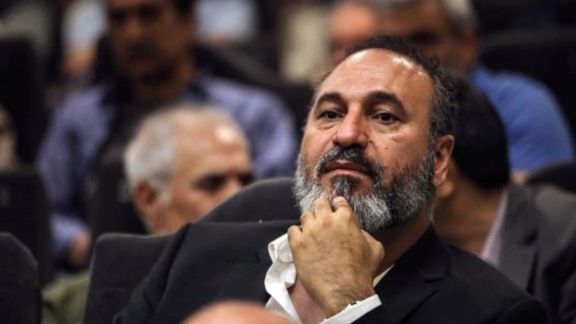
A famous Iranian actor has lashed out at the Supreme Leader Ali Khamenei saying at least try to be a “personable dictator”.

A famous Iranian actor has lashed out at the Supreme Leader Ali Khamenei saying at least try to be a “personable dictator”.
Hamid Farrokhnejad, in a post on his Instagram page compared Ali Khamenei with other dictators such as Francisco Franco, Mao Zedong, Joseph Stalin and Benito Mussolini, saying he is “mentally ill” just like his “colleagues”.
According to Farrokhnejad, “personable” dictators accept their fate when they get close to the end, but the “impersonable” ones, choose the costly way that leads to high casualties.
“Over time, all dictators have the illusion of assuming themselves as God, and they think they are absolutely right and eternal…but they are all mentally ill,” he added.
He also warned that the second group will die very severely, as people will take revenge from their subordinates and appointees due to the anger of the people who suffered many casualties.
Since the uprising in Iran, artists in various fields have publicly expressed solidarity with the protesters and criticized the Islamic Republic and its leaders in an unprecedented manner.
Over the past three months, the literature used to address Supreme Leader Ali Khamenei in Iran has been unprecedented, full of insults and outright rejection.
The US-based Human Rights Activists News Agency (HRANA) announced in its latest report that from September 17 until Tuesday, December 13, at least 493 protestors have been killed in Iran, of which at least 68 were minors.

The WWII Danish schoolboys club that launched acts of sabotage against the Nazis has inspired the formation of similar groups among anti-regime protesters in Iran.
The Churchill Club (Churchill-klubben in Danish) was a group of eight teenage schoolboys who under the leadership of the sixteen-year-old Knud Pedersen began targeting German occupation forces in Aalborg in 1941 and succeeded in carrying out 25 acts of sabotage before being arrested some months later.
The idea of small, independent cells to target the government and security forces with acts of sabotage across Iran was proposed by an activist on Twitter only three days ago but has already become quite popular with others on social media, who have created the “Shekari Club” hashtag and are heatedly discussing it.
Mehdi Hajati who proposed the idea in a tweet Monday, also suggested that “honorable sabotage” groups be named after Mohsen Shekari, a 23-year-old protester whose execution Thursday has enraged many Iranians.
Already, acts of sabotage directed at the government have also been reported in the past three months including firebombing buildings belonging to the Basij militia of the Revolutionary Guards (IRGC), offices of government-appointed Friday imams and lawmakers, statues of Qasem Soleimani, the Qods Force commander who was killed by the US in Baghdad in January 2020, and banners of Supreme Leader Ali Khamenei in various cities.
The voice in the video says the governor’s office in Shandiz, near the city of Mashhad in northeast Iran, was set on fire Wednesday in retaliation for the execution of Mohsen Shekari and Majidreza Rahnavard.
Pundits in Iran have warned that as the government offers no olive branch to the disgruntled population and hangs young people who have no criminal record, it pushes the protests to a revolutionary phase, and one of the characteristics of this phase would be underground activities.
Hajati explained that ‘Shekari Clubs’ can consist of two to several members who act independently and have no connection with each other. They can destroy “anything that belongs to the government or serves it”. He argued that “honorable sabotage” could help in the war against the regime now that protester turnout on the streets has dropped “for whatever reason”.
He also suggested that these groups target urban CCTV cameras as a first step in their activities as security forces use them to identify and arrest protesters.
Both Mohsen Shekari and Majidreza Rahnavard, a second protester hanged December 12 were caught with the help of footage taken by urban and private CCTV cameras. He proposed to issue a warning to citizens to remove their CCTV cameras in public places within a certain period before targeting them.
Hajati, an expatriate former reformist member of Shiraz City Council, was known for his anti-corruption campaigns during his tenure. He left the country after a year of imprisonment for defending the rights of the outlawed Baha’i religious minority.
An expatriate former police lieutenant who says he had to flee Iran after refusing to suppress protests in 2018, Fariborz Karamizand, has also been encouraging protesters to target CCTV cameras, which he calls “Satan’s eyes”.
Using his own experience, Karamizand who has become extremely popular on social media regularly posts videos to teach protesters how to fight against security forces on the streets and how to target government buildings or carry out other acts of sabotage against it.

Despite all the tactics the Islamic Republic used to keep its seat at the UN women’s commission, the international community dealt another blow over its rights violations.
In its last session of the year, 29 members of the 54-member UN Economic and Social Council (ECOSOC) voted in favor of a US-drafted resolution to "remove with immediate effect the Islamic Republic of Iran from the Commission on the Status of Women (CSW) for the remainder of its 2022-2026 term."
The move was the first time in United Nations history that a country was expelled from the commission, and the second blow to the Islamic Republic over its brutal crackdown on protests sparked by the death of 22-year-old Mahsa Amini in custody of hijab police. The first step to hold the Islamic Republic accountable was creating a fact-finding mission by the Human Rights Council. The Geneva-based UN Human Rights Council voted on November 24 to launch an independent investigation into the regime’s deadly repression that has killed around 500 civilians, including about 60 children.
Iran had tried its best to keep itself part of the commission through rallying its allies and a behind-the-scenes campaign to exert pressure on academic figures to send letters to numerous global bodies to urge them vote against the move. However, the result of was not unexpected as the regime’s membership in the commission was repeatedly condemned even before the current wave of protests.
During the Wednesday session, the Islamic Republic and its friends, including China and Russia, argued that the expulsion of Iran sets a precedent that may be used against other members in the future. As usual, Tehran’s main strategy was not to address the problem directly but instead accuse other countries of human rights violations.
Another strategy of the pro-Tehran camp was to count on countries that have grievances against the US. Iran's UN Ambassador Amir Saeid Iravani called the move illegal, describing the United States as a bully. "The US request is entirely illegal, as the Council members are fully aware that there is no precedent in the council practice of terminating an elected member's participation in a functional commission for any other reason,” Iravani said.
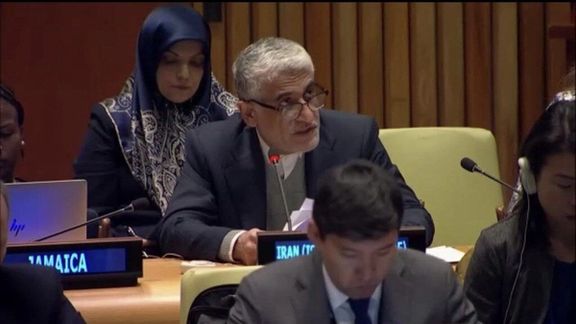
The Russian envoy also tried to make the best use of UN technicalities to stop the vote, asking for a legal review of the draft, but Moscow’s motion was annulled by a quick vote before the main decision.
China's Deputy UN Ambassador Geng Shuang said, "Addressing human rights and women's issues by means of removing Iran from CSW would only set a dangerous precedent, send out the wrong message and bring about negative consequences."
The countries in favor of expelling Iran from the CSW were of the opinion that its membership would be a stain on the name of the commission as the principal global intergovernmental body exclusively dedicated to the promotion of gender equality and the empowerment of women. The text of the draft resolution denounced Iran's policies as "flagrantly contrary to the human rights of women and girls and to the mandate of the Commission on the Status of Women."
Referring to the Iranian protesters, US Ambassador to the UN, Linda Thomas-Greenfield, told ECOSOC that "These women and activists have appealed to us, the United Nations, for support. They made their requests to us loud and clear -- remove Iran from the Commission on the Status of Women.”
She argued that it cannot do its important work “if it's being undermined from within. Iran's membership at this moment is an ugly stain on the commission's credibility.” She noted, “There are few, obviously, right and wrong answers in diplomacy. But today, today we have an opportunity to do something that is clearly the right thing to do. We can act in this moment to support women. We can act in direct response to our constituents, the global community of women.”
The move has been welcomed by many Western countries, many Iranians and activists. In a statement after the vote, US National Security Advisor Jake Sullivan described it as yet “another sign of the growing international consensus on Iran and demands for accountability.”
“Over the last week alone, the United States has issued three separate sets of sanctions targeting Iran’s financing of terror, protest-related human rights violations, and provision of UAVs to Russia for attacks against Ukraine’s critical infrastructure. We have acted in coordination with the EU, UK, Canada, Australia, and others who have issued new sanctions under their own authorities," read the statement.
Israeli Prime Minister Yair Lapid also praised the decision, saying, "Iran's killing of Mahsa Amini and its blatant violations of women's rights disqualify it from being a member of a committee that deals with women's rights.”
Canada-based activist Hamed Esmaeilion, whose daughter and wife were killed by the IRGC, also hailed the action, calling the regime authorities “the enemies of women, life and freedom.”
Former Donald Trump State Department spokesperson Morgan Ortagus tweeted, “Victory! The Iranian regime has been kicked off the UN Women’s Commission! At last, a small but important measure of accountability against the Islamic Republic of Iran for their gender apartheid and crimes against women."
Iranians in several cities, including the capital Tehran and in the Kurdish city of Saqqez, the hometown of Mahsa Amini, poured out onto streets celebrating the decision. Most of them see this as a victory because it may lead to more international measures, or at least make the regime retreat from its iron-fisted crackdown.
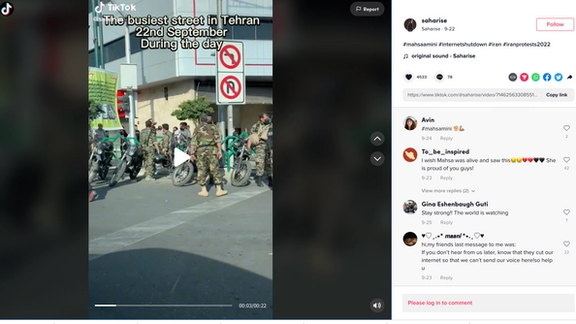
Images of the protests that followed the death of Mahsa Zhina Amini and reports of the government’s brutal crackdown have circulated widely on social media.
This flow of information comes despite efforts by the Iranian regime to throttle internet access and censor information leaving the country.
One effective method the protesters have hit on has been to use TikTok, the video-sharing app better known for young people posting clips of themselves singing and dancing. The way video clips are shared on the social media platform and the protesters’ clever use of labeling have helped activists circumvent the information blockade of Iran’s tech-savvy security services and reach a wide audience.
As a researcher who studies young people and participatory culture – art and information produced by nonspecialists, including fan fiction and citizen journalism – I believe that TikTok is proving to be an effective tool of political activism in the face of severe repression.
Key to its effectiveness is how TikTok works. Each TikTok video recorded by the user is typically 60 seconds or shorter and loops when finished. Other users can edit or “stitch” someone else’s TikTok video into their own. Users can also create a split screen or “duet” TikTok video, with the original video on one side of the screen and their own on the other.
Stitching and duetting
To use TikTok, a protester in Iran typically uses multihop virtual private networks, meaning VPNs that send internet traffic through multiple servers, to route around government internet blackouts just long enough to post a video to TikTok. There, TikTok users who support the protester “like” the video thousands of times, stitch it into other videos, and duet it to then be liked, stitched and duetted again and again.
In the process, identifying information about the original poster is obscured. Within minutes the protester becomes anonymous even as the message spreads. Even if the video is flagged for violating TikTok’s community guidelines, its sharers like and incorporate its duets too quickly for TikTok to remove the original content from the platform completely.
In one video that has received over 620,000 views, Iranian-American attorney Elica Le Bon urges viewers to share all Iranian content to make sure the world keeps paying attention. In another, TikTok user @gal_lynette directs her 35,000 followers to instantly duet videos made by Iranian women as a form of citizen journalism to “keep their reporting – their story … alive.”

Gaming the algorithms
Elsewhere, TikTok user @m0rr1gu tells her 44,000 followers how to share that content without triggering community guidelines violations. This advice includes using “algospeak,” or code, for bypassing community guidelines violations. For TikTokkers boosting Iranian content, this means altering the word “Iran” in captions, among other tactics.
Gaming TikTok’s algorithm helps ensure that the people most likely to share this content can find it. For example, Iranian-American TikTokker Yeganeh Mafaher tapped a recent celebrity scandal’s virality by titling a video “Adam Levine Also DMd Me,” only to announce “Okay, now that I have your attention, the internet is going to be cut off in Ir@n.”
By removing the word “Iran” but leaving Levine’s name searchable, Yeganeh was gaming the algorithm to help her retain her viewers who were seeking Iranian content while also “hashbaiting” additional users who were following the celebrity scandal. Up to that point, Yeganeh’s most-viewed revolution-related video was a history of hijab laws that garnered nearly 341,000 views. The Levine video exceeded 1.6 million.
Yeganeh’s account had previously recorded her experiences as an Iranian-American citizen and attracted followers interested in Iranian culture. After Amini’s death, she credited her followers with boosting her account to the point that she was interviewed by cable news host Chris Cuomo on NewsNation to discuss the uprising.
Song of a movement
A key element of a TikTok video is its audio track or “sound,” often a song that provides a thematic thread across stitched and duetted videos. The sound of many of the videos depicting the events in Iran, with more than 11.7 million views, is the song “Baraye” by Iranian singer-songwriter Shervin Hajipour.
The song’s lyrics are derived from a string of Farsi tweets that detail Iranians’ reasons for revolution. Hajipour was detained because of the song but was later released. “Baraye” has since become a global protest ballad.
Worried for Hajipour’s safety, TikTokkers supporting the uprising united in an effort to shield him from backlash by posting thousands of videos directing users to nominate “Baraye” for the Grammy’s newest special merits award, best song for social change. In October, the song had received 83% of the 115,000 nominations, which has increased international attention on Hajipour and the song.
“Baraye” and related hashtags are shared resources that help make TikTok a platform for participatory politics. As the world watches Iran, TikTokkers game the platform’s algorithms to amplify Iranians’ videos beyond the reach of the Iranian government.
There are active TikTok campaigns for everything from Grammy nominations to scripting emails to local representatives and global leaders. Videos teach laypeople to discreetly host Iranian web traffic and direct users to local protests. They share petitions for G-7 leaders to expel Iran’s diplomats and the U.N. to hold the Iranian government accountable for its crimes against international law. As state executions of protesters have begun in Iran, the #StopExecutionsInIran campaign has clocked over 100 million views on TikTok.
These interactive tools and the platform’s algorithm for promoting content are what transformed TikTok from teen dance app to powerful global platform for protest and political action. While much is uncertain as Iranians fight for change and their supporters worldwide flood an unlikely platform to boost their voices, one thing seems likely: The revolution may not be televised, but it will be liked, stitched and duetted.
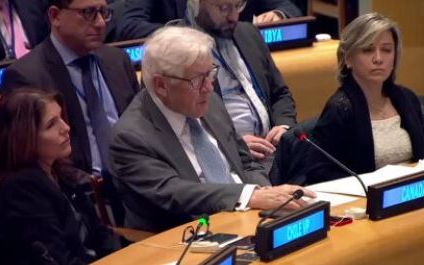
The Islamic Republic was voted out from the United Nations Commission on the Status of Women (CSW) for policies contrary to the rights of women and girls.
On Wednesday, members of the UN Economic and Social Council (ECOSOC) adopted a US-drafted resolution to "remove with immediate effect the Islamic Republic of Iran from the Commission on the Status of Women for the remainder of its 2022-2026 term" over the regime’s bloody crackdown on protests ignited by the death of a young woman in custody of hijab – or the so-called “morality” -- police.
“This vote is another sign of the growing international consensus on Iran and demands for accountability,” US National Security Advisor Jake Sullivan said after the vote.
The Commission on the Status of Women (CSW) is the principal global intergovernmental body exclusively dedicated to the promotion of gender equality and the empowerment of women.
Out of the 54-member body, 29 members voted in favor of the resolution while eight voted against and 16 countries abstained. The Islamic Republic itself, Palestine, Syria, Cuba, China, Russia, Eritrea, Belarus, Zimbabwe, and North Korea voted to keep Iran in the body.
The vote was the first time in United Nations history that a country was expelled from the commission.
It was the second step against the Islamic Republic’s violations of human rights during the current wave of protests. The first step by the United Nations to hold the Islamic Republic accountable for its crackdown on protesters was creating a fact-finding mission by the Human Rights Council. The Geneva-based UN Human Rights Council voted on November 24 to launch an independent investigation into the regime’s deadly repression of protests that has killed around 500 civilians, including about 60 children.
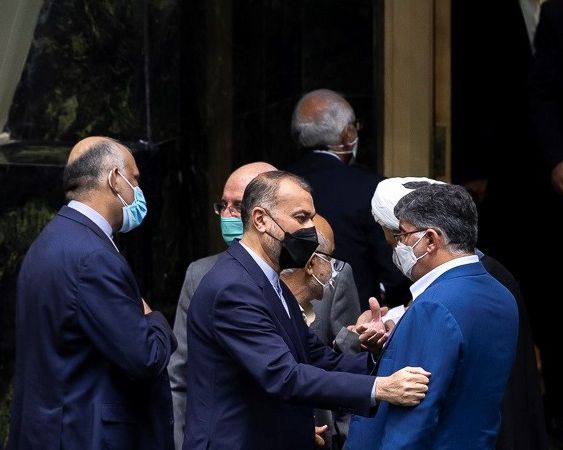
Scores of Iranian lawmakers have slammed what they call France's “interference” in Iran’s internal affairs after Paris condemned the execution of protesters.
In a statement on Wednesday, 194 members of Iranian parliamentarians condemned the recent solidarity of French lawmakers and senior officials, including President Emmanuel Macron and Foreign Minister Catherine Colonna with Iranian demonstrators.
According to IRNA News Agency, the MPs claimed the French officials’ recent remarks are “contrary to the principle of non-interference in the affairs of countries, which is one of the fundamental principles of international law and the principles included in the United Nations Charter.”
The statement also accuses the French president of “supporting the MEK leaders” saying he holds meetings with Iran’s “opposition groups who are officially seeking to overthrow the Islamic Republic.”
The Iranian lawmakers also alleged that Macron sends “his spies” into Iran to “disturb” the county’s national security by participating in “riots” and managing them.
Iran's parliament is packed with hardliners and many Revolutionary Guard officers.
Earlier, Paris summoned Iran’s charge d’affaires over the supply of weapons to Russia used in Ukraine and crackdown on protesters. FM Catherine Colonna told Reuters that the Iranian diplomat was also questioned over the treatment of seven French nationals who are currently in custody in Iran.
France’s foreign ministry on Monday also condemned the public execution of Majidreza Rahnavard who was sentenced to death following his participation in the protests currently under way in Iran.